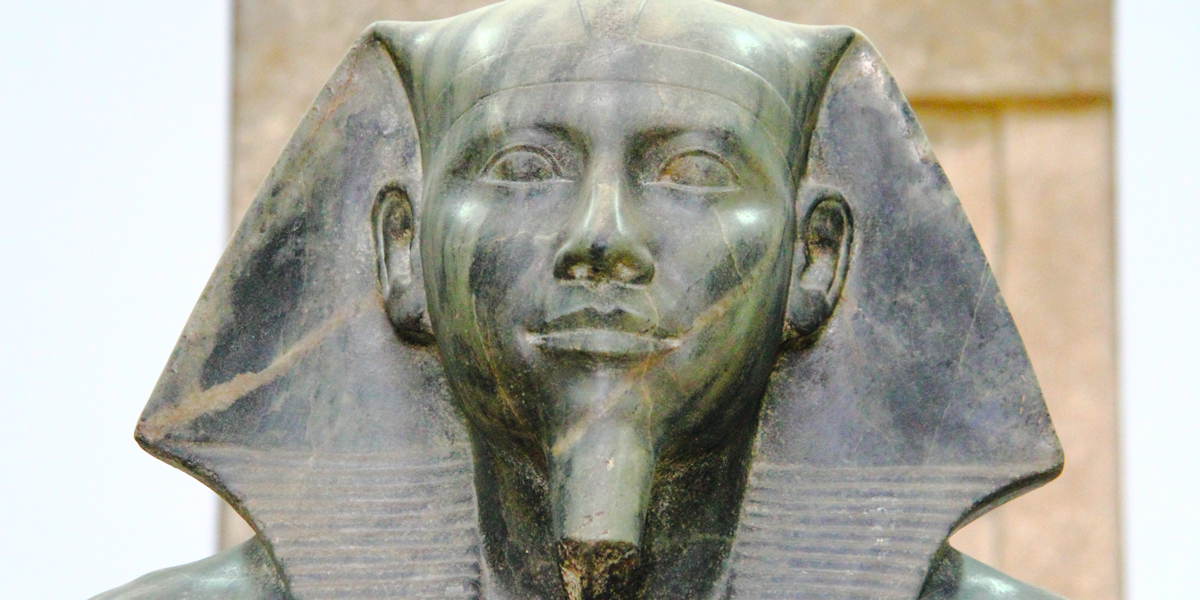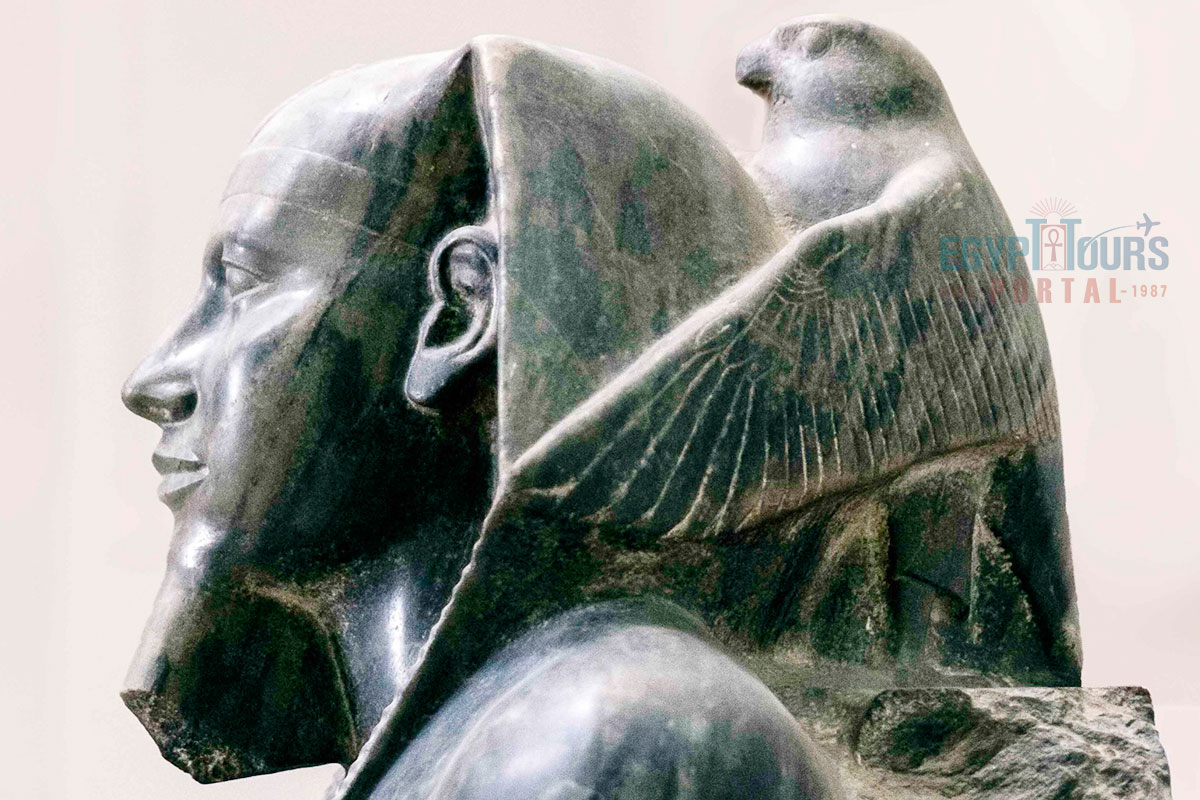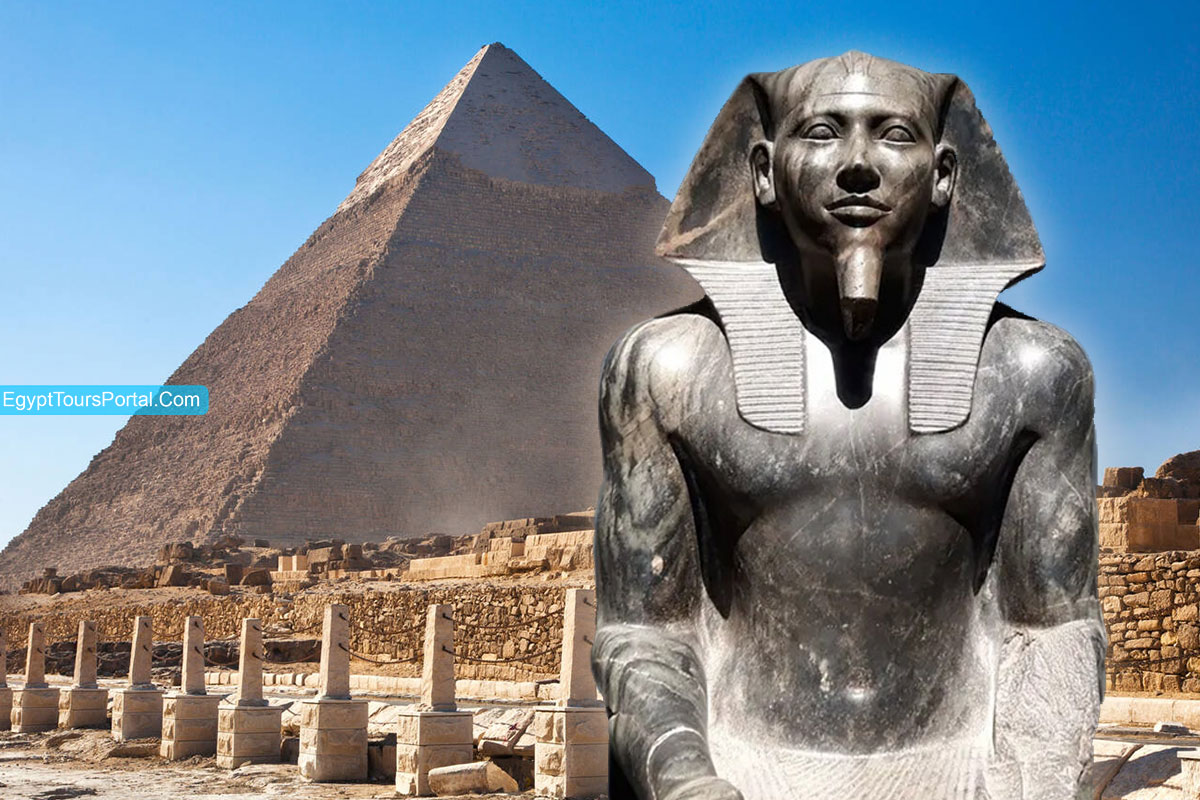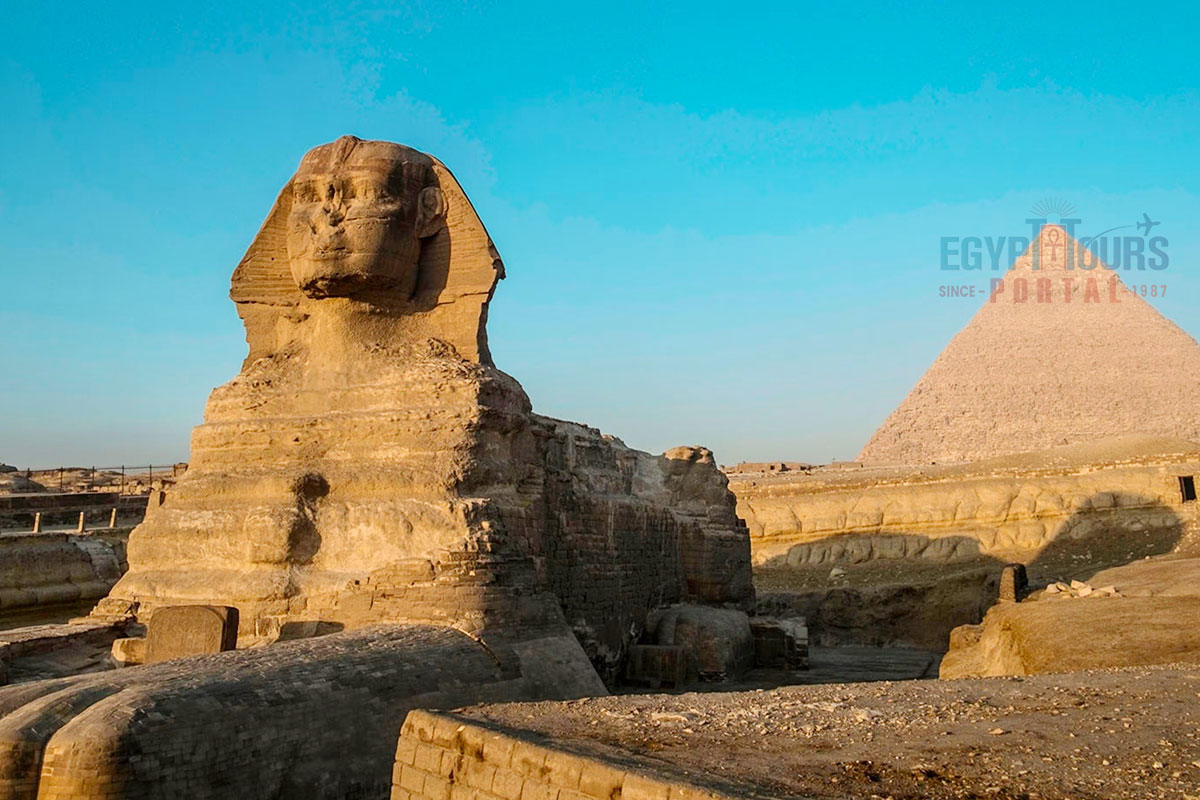- Local Time: 08:32 PM
- Weather: 15 ℃ / 60 ℉
King Khafre, a key ruler of Egypt’s Fourth Dynasty and son of Pharaoh Khufu, is remembered for overseeing a golden age of architectural and cultural achievement. His reign produced the iconic second pyramid at Giza and the Great Sphinx, symbolizing divine kingship. Through dynastic alliances and artistic legacy, Khafre maintained political stability and left a profound mark on Egyptian history. Though historical views vary, archaeology confirms his lasting influence as both a powerful monarch and mythic figure in Egypt’s heritage.

King Khafre comes to life every time the sun casts golden hues upon the mighty stones of the second pyramid of Giza, where there rests the legacy of King Khafre, who is an enigmatic ruler whose reign echoes through eternity. Khafre, the son of the legendary Pharaoh Khufu, shaped his place in history as the creator of timeless wonders that seem to defy both man and nature.
Towering beneath the sun’s radiant gaze stands his pyramid, a colossal monument that reaches toward the heavens, second only to his father’s in size and splendor. Yet perhaps the most mystical of all is the Great Sphinx, carved from limestone, silently watching over Khafre’s pyramid with a gaze that holds the wisdom and mysteries of an ancient world. Khafre’s reign was one of transformation and artistic magnificence, blending divine authority with architectural mastery.
In the whispers of the wind and the shadows of the desert, the essence of Khafre lives on, immortalized in stone and spirit. His name, etched into history and the dreams of his people, carries the magic of a pharaoh who sought not just to rule, but to ascend, his legacy shimmering in the sands, as eternal as the stars above Egypt’s ancient kingdom.

King Khafre, also known as Chephren, was an influential ruler of ancient Egypt’s Old Kingdom (2686-2150 BC), ascending to the throne around 2558 BC to 2532 BC as the fourth king of the Fourth Dynasty. His name means "The Appearing of Ra". He was the son of the legendary Pharaoh Khufu, builder of the Great Pyramid, and succeeded his elder brother, Djedefre, to rule Egypt during a period marked by monumental achievements in architecture, art, and royal power consolidation.
Khafre’s legacy is predominantly tied to his grand architectural contributions at Giza, including his pyramid complex and the enigmatic Great Sphinx, believed by most Egyptologists to have been constructed under his reign. Despite the grandeur of his monuments, ancient Greek historians like Herodotus and Diodorus depicted Khafre as a harsh ruler, though these accounts contrast with Egyptological evidence suggesting stability and artistic flourishing during his reign.

King Khafre’s family tree is intricately connected to the prominent rulers of Egypt’s Fourth Dynasty. He was the son of King Khufu and possibly Queen Meritites I or Queen Henutsen. His succession followed that of his brother Djedefre, who took the throne briefly after Khufu’s death. Khafre married multiple queens, including Meresankh III, Khamerernebty I, and Hekenuhedjet, producing a large royal lineage. His main wife was Queen Mereceankh and he had 12 sons and 3 daughters.
His sons included Menkaure, who would later succeed him as pharaoh, as well as prominent princes such as Nebemakhet and Duaenre. The royal bloodline extended through his daughters, like Shepsetkau, who solidified alliances through strategic marriages. This extensive family network allowed Khafre to maintain a strong dynastic presence in Egypt, linking him to a legacy of rulers who shaped the era’s cultural and architectural advancements.

King Khafre’s reign, which lasted approximately 24 to 26 years, was a defining period in Egypt’s Old Kingdom history. Despite discrepancies in historical sources with the ancient historian Manetho suggesting a 66-year rule, most scholars agree on a shorter duration. The absence of precise records on the Turin King List and other sources complicates the exact dating, but a carved inscription on the tomb of Khafre’s son, Nekure, suggests a rule of just over two decades.
Khafre’s time as pharaoh was marked by stability, architectural innovation, and grand construction projects, including his pyramid and temple complexes at Giza. These achievements emphasized the pharaoh’s divine role, while his political alliances and strategic marriages strengthened his dynasty’s influence.

King Khafre’s accomplishments stand as testaments to the splendor of the Old Kingdom. He constructed the Pyramid of Khafre, the second-tallest pyramid at Giza, renowned for its well-preserved outer casing that glimmers in the sunlight. Additionally, the Great Sphinx of Giza, a colossal limestone statue believed to represent Khafre himself, was likely carved during his reign as a symbol of royal power and guardian of the necropolis.
Khafre’s architectural contributions extended to complex mortuary and valley temples, with stunning statues that have survived through the millennia. These accomplishments reflect not only his vision but also his era’s unparalleled craftsmanship, making his reign one of the most distinguished in ancient Egypt’s monumental history.

King Khafre died around 2532 BC, though the circumstances of his death remain unknown. His burial took place within his grand pyramid at Giza, a structure celebrated for its enduring legacy and architectural ingenuity. Khafre’s pyramid complex includes a mortuary temple, where rituals were performed to honor the pharaoh, and a valley temple containing statues of the king that highlight the sophisticated artistry of his reign.
His final resting place was guarded by the Great Sphinx, further amplifying the grandeur of his tomb. The entire complex underscores the significance placed on the afterlife in Egyptian culture, designed to ensure Khafre’s eternal protection and status among the gods.
King Khafre changed the shape of history and constructed one of the most renowned archaeological wonders in Giza, which everyone can explore through our incredible Egypt holiday packages and nile cruise holidays that shed light on the heritage and beauty of this immortal civilization that will make your vacation worthy of cherishing.
Private 4 Days Cairo Tour Packages for British Travelers 4 days Cairo Egypt Tour pac...
Tour Location: Cairo – Giza...
5 Days Cairo and Alexandria Tour Package For British Travelers 5 days Cairo and Alex...
Tour Location: Cairo/Giza/Alexandria...
6 Days Cairo, Luxor & Aswan Tour Package For British Travelers 6 days Cairo, Lux...
Tour Location: Cairo/Giza/Aswan/Luxor...
Amazing 7 Days Cairo and Hurghada Holiday for British Travelers 7 Days Cairo & H...
Tour Location: Cairo – Giza – Hurgh...
The Pyramid of Khafre is famous for its architectural design and grandeur, being the second-largest pyramid in Egypt. Its prominence is enhanced by the fact that it retains sections of its original limestone casing, creating the appearance of a capstone that reflects sunlight brilliantly.
Situated on the Giza Plateau alongside the Great Pyramid of Khufu and the Pyramid of Menkaure, Khafre’s pyramid is part of a remarkable complex that includes temples and the Great Sphinx, a symbol of power associated with his reign. This iconic structure exemplifies the advanced engineering and artistic skill of the ancient Egyptians, drawing visitors from around the world.
The statues of Khafre are essential for understanding ancient Egyptian art, royal iconography, and religious beliefs. The most famous statue of Khafre, housed in the Egyptian Museum in Cairo, depicts him seated majestically with a protective falcon, symbolizing the god Horus, behind his head.
This statue captures the pharaoh’s divinity, authority, and connection to Horus, reinforcing his role as a god-king on Earth. Discovered in the valley temple of his pyramid complex, these statues were likely intended to serve as eternal embodiments of the king, ensuring his presence and reverence in both life and the afterlife.
Khafre’s pyramid yielded limited burial artifacts compared to later pyramids, but it holds significant architectural and artistic elements, including his mortuary and valley temples. Excavations uncovered statues of Khafre, many featuring his iconic depiction of Horus.
The pyramid’s passageways and burial chamber, though looted in antiquity, demonstrate the advanced construction methods of the Fourth Dynasty, with intricately cut granite and limestone. Inscriptions and architectural features within the complex add to the understanding of the rituals surrounding pharaonic burials and underscore the pyramid’s role as a site of worship and remembrance.
Khafre ascended to the throne after the death of his elder brother, Djedefre, and his father, King Khufu. The exact details surrounding his rise are unclear, but it is believed he inherited the throne as part of a traditional succession in the Fourth Dynasty.
As Khufu’s son, Khafre held a legitimate claim, reinforced by his mother and several strategic alliances formed through marriage. His accession was likely a continuation of his family’s dynastic rule, maintaining the legacy of his father and the monumental architectural pursuits that defined Egypt’s Old Kingdom.
The entire country of Egypt deserve to be explored with its every heavenly detail but there are places that must be seen before any other such as the breathtaking Hurghada's red sea, The wonders of Cairo the pyramids of Giza, the great sphinx, the Egyptian Museum, Khan El Khalili Bazaar, the wonders of Luxor like Valley of the Kings, Karnak & Hatshepsut temple and the wonders of Aswan such as Abu Simbel temples, Philea temple, Unfinished obelisk and The Wonders of Alexandria like Qaitbat Citadel, Pompey's Pillar and Alexandria Library. Read more about the best places to visit in Egypt.
If you want to apply for a Visa On Arrival that lasts for 30 days then you should be one of the eligible countries, have a valid passport with at least 6 months remaining and pay 25$ USD in cash, as for the E-Visa for 30 day you should have a valid passport for at least 8 months, complete the online application, pay the e-visa fee then print the e-visa to later be presented to the airport border guard. You could also be one of the lucky ones who can obtain a free visa for 90 days. Read more about Egypt travel visa.
Egypt has a variety of delicious cuisines but we recommend “Ful & Ta’meya (Fava Beans and Falafel)”, Mulukhiya, “Koshary”, a traditional Egyptian pasta dish, and Kebab & Kofta, the Egyptian traditional meat dish.
The best time to travel to Egypt is during the winter from September to April as the climate becomes a little tropical accompanied by a magical atmosphere of warm weather with a winter breeze. You will be notified in the week of your trip if the Climate is unsafe and if any changes have been made.
You should pack everything you could ever need in a small bag so you could move easily between your destinations.
We have been creating the finest vacations for more than 20 years around the most majestic destinations in Egypt. Our staff consists of the best operators, guides and drivers who dedicate all of their time & effort to make you have the perfect vacation. All of our tours are customized by Travel, Financial & Time consultants to fit your every possible need during your vacation. It doesn't go without saying that your safety and comfort are our main priority and all of our resources will be directed to provide the finest atmosphere until you return home.
You will feel safe in Egypt as the current atmosphere of the country is quite peaceful after the government took powerful measures like restructuring the entire tourist police to include all the important and tourist attractions in Egypt. Read more about is it safe to travel to Egypt.
Wear whatever feels right and comfortable. It is advised to wear something light and comfortable footwear like a closed-toe shoe to sustain the terrain of Egypt. Put on sun block during your time in Egypt in the summer to protect yourself from the sun.
The best activity is by far boarding a Nile Cruise between Luxor and Aswan or Vise Versa. Witness the beauty of Egypt from a hot balloon or a plane and try all the delicious Egyptian cuisines and drinks plus shopping in old Cairo. Explore the allure and wonders of the red sea in the magical city resorts of Egypt like Hurghada and many more by diving and snorkeling in the marine life or Hurghada. Behold the mesmerizing western desert by a safari trip under the heavenly Egyptian skies.
There are a lot of public holidays in Egypt too many to count either religious or nation, the most important festivals are the holy month of Ramadan which ends with Eid Al Fitr, Christmas and new years eve. Read more about festivals & publich holidays in Egypt.
Egypt is considered to be one of the most liberal Islamic countries but it has become a little bit conservative in the last couple of decades so it is advised to avoid showing your chest, shoulders or legs below the knees.
Arabic is the official language and Most Egyptians, who live in the cities, speak or understand English or at least some English words or phrases. Fewer Egyptians can speak French, Italian, Spanish, and German. Professional tour guides, who work in the tourism sector, are equipped to handle visitors who cannot speak Arabic and they will speak enough English and other languages to fulfill the needs of all our clients.
The fastest way is a car, of course, a taxi. If you are in Cairo ride a white taxi to move faster or you could board the fastest way of transportation in Egypt metro if the roads are in rush hour.
The temperature in Egypt ranges from 37c to 14 c. Summer in Egypt is somehow hot but sometimes it becomes cold at night and winter is cool and mild. The average of low temperatures vary from 9.5 °C in the wintertime to 23 °C in the summertime and the average high temperatures vary from 17 °C in the wintertime to 32 °C in the summertime. The temperature is moderate all along the coasts.
It is the home of everything a traveler might be looking for from amazing historical sites dating to more than 4000 years to enchanting city resorts & beaches. You will live the vacation you deserve as Egypt has everything you could possibly imagine.









